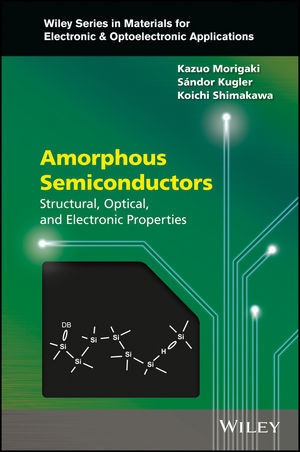Read more
Informationen zum Autor Kazuo Morigaki, Professor Emeritus, University of Tokyo. Morigaki received his Ph.D. degree in physics from Osaka University in 1959. Since then, he has joined Osaka University, Sony Corporation Research Laboratory, Centre d'Etudes Nuclèares de Saclay, University of Tokyo (Institute for Solid State Physics), Yamaguchi University and Hiroshima Institute of Technology. Sandor Kugler , Associate Professor, Department of Theoretical Physics, Budapest University of Technology and Economics, Hungary. Kugler received both his degree in and his PhD in physics from ELTE, Budapest. He joined the quantum theory group, Institute of Physics, Technical University of Budapest, during 1974-1993 as research associate. Since 1993, he has been Associate Professor. Koichi Shimakawa , Professor Emeritus and Fellow, Gifu University, Japan. Shimakawa received his PhD from Nagoya University in 1975. Since then, he has been at Gifu University, becoming Professor in the period 1989-2008. He retired from Gifu University in 2008, and is senior researcher, Nagoya Industrial Science Institute, Nagoya, and visiting Professor, Department of Chemistry, University of Pardubice, Czech Republic. Klappentext Amorphous semiconductors are subtances in the amorphous solid state that have the properties of a semiconductor and which are either covalent or tetrahedrally bonded amorphous semiconductors or chelcogenide glasses.* Developed from both a theoretical and experimental viewpoint* Deals with, amongst others, preparation techniques, structural, optical and electronic properties, and light induced phenomena* Explores different types of amorphous semiconductors including amorphous silicon, amorphous semiconducting oxides and chalcogenide glasses* Applications include solar cells, thin film transistors, sensors, optical memory devices and flat screen devices including televisions Zusammenfassung Amorphous semiconductors are subtances in the amorphous solid state that have the properties of a semiconductor and which are either covalent or tetrahedrally bonded amorphous semiconductors or chelcogenide glasses. Inhaltsverzeichnis Series Preface xi Preface xiii 1 Introduction 1 1.1 General Aspects of Amorphous Semiconductors 1 1.2 Chalcogenide Glasses 3 1.3 Applications of Amorphous Semiconductors 3 References 3 2 Preparation Techniques 5 2.1 Growth of äSi:H Films 5 2.1.1 PECVD Technique 5 2.1.2 HWCVD Technique 6 2.2 Growth of Amorphous Chalcogenides 6 References 8 3 Structural Properties of Amorphous Silicon and Amorphous Chalcogenides 11 3.1 General Aspects 11 3.1.1 Definitions of Crystalline and Noncrystalline 11 3.2 Optical Spectroscopy 12 3.2.1 Raman Scattering 12 3.2.2 Infrared Absorption 13 3.3 Neutron Diffraction 15 3.3.1 Diffraction Measurements on Amorphous Silicon 17 3.3.2 Diffraction Measurements on Hydrogenated Amorphous Silicon 18 3.3.3 Diffraction Measurements on Amorphous Germanium 19 3.3.4 Diffraction Measurements on Amorphous Selenium 19 3.4 Computer Simulations 20 3.4.1 Monte Carlo¿Type Methods for Structure Derivation 20 3.4.2 Atomic Interactions 21 3.4.3 äSi Models Constructed by Monte Carlo Simulation 25 3.4.4 Reverse Monte Carlo Methods 26 3.4.5 äSi Model Constructed by RMC Simulation 28 3.4.6 äSe Model Constructed by RMC Simulation 30 3.4.7 Molecular Dynamics Simulation 32 3.4.8 äSi Model Construction by Molecular Dynamics Simulation 34 3.4.9 äSi:H Model Construction by Molecular Dynamics Simulation 34 3.4.10 äSe Model Construction by Molecular Dynamics Simulation 35 3.4.11 Car and Parrinello Method 38 References 38 4 Electronic Structure of Amorphous Semiconductors...

